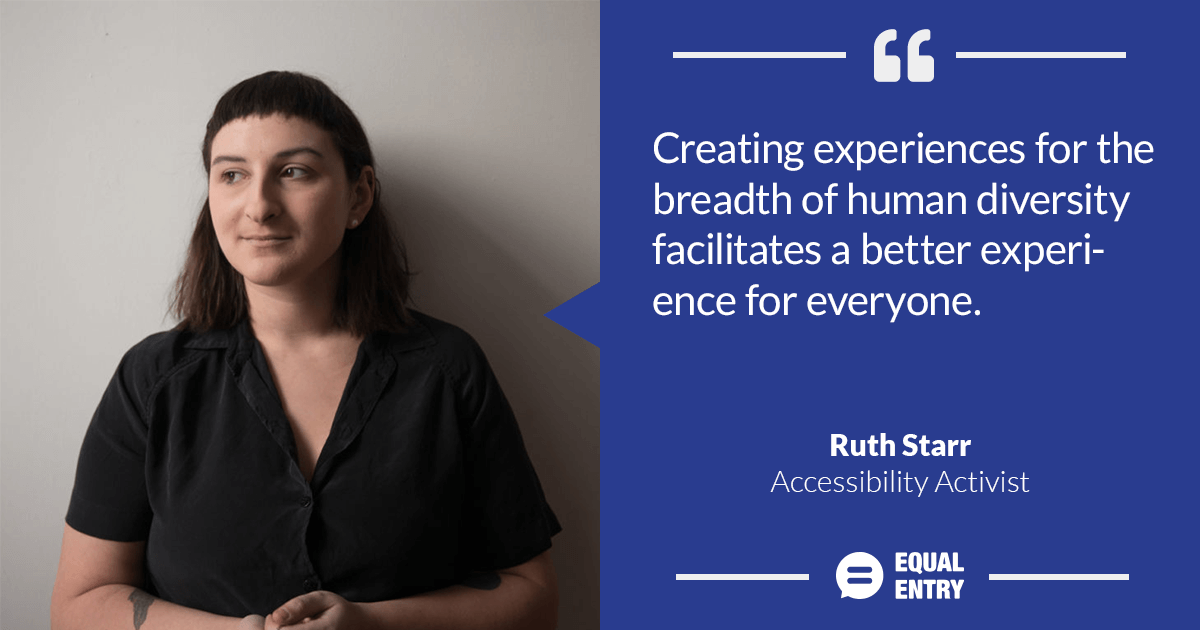Summary

Ruth Starr is an arts administrator and educator currently serving as the inaugural Accessibility Manager at Cooper Hewitt, Smithsonian Design Museum. Cooper Hewitt is committed to broadening its audiences and ensuring the museum is welcoming to all. Ruth is also Communications Chair of the Museums, Arts and Culture Access Consortium, a network of cultural professionals and advocates working to further accessibility in the New York City metro area.
How did you get started in accessibility?
My path to cultural accessibility seems carefully planned but really wasn’t. A few identities that in some ways merge into this field: an arts educator and an ASL Interpreter. I studied museology at the Rochester Institute of Technology/ National Technical Institute for the Deaf while training as an interpreter and discovered the work being done in cultural accessibility at museums here in New York. As an artist, I’ve always been drawn to museums for the stories and objects that they share. I also perceive museums as inherently community spaces that have a social responsibility to the public. Now, in my role as a museum worker I have the opportunity to interrogate how museums engage with people. In this, my hope is to challenge organizations to consider all visitors, including those who will never walk through our doors.
In your observation as an expert in museum accessibility, what are the unique challenges to providing an accessible cultural experience to all museum visitors?
A common challenge to many cultural organizations in furthering accessibility is a misbelief that visitors with disabilities represent only a small subset of our audience so it doesn’t need to be prioritized. This is really counter to the philosophy of inclusive design which presents that creating experiences for the breadth of human diversity in fact facilitates a better experience for everyone. As with any public service role, museum workers also are passionate about the work they do, but function in a larger bureaucratic system. This really applies to all issues of equity within the cultural space—but the tension between allyship, responsibility, and individual agency to get the work done is also something that I think many cultural workers exist within. Museums have a deeply rooted history in exclusion that in many ways is by design. The hours they are open, the geography of where they were built within cities— there is a longstanding history of questioning audience—just who they are for? Much of the work being done today is aimed at dismantling these origins.
What distinguishes the Cooper Hewitt, Smithsonian Design Museum in terms of accessibility features?
As the nation’s design museum, Cooper Hewitt has a unique position in the cultural accessibility space as barriers and issues of inaccessibility were at one point in history, designed. The museum has active initiatives that aim to further disability inclusion including staff trainings, ongoing accessibility services, education programs, and exhibition practices. Beyond this, Cooper Hewitt aims to educate about inclusive design to ensure that these principles are included in broader conversations of design literacy. Through ongoing discussions and education programs, Cooper Hewitt provides a platform for dialogue around disability inclusion across design disciplines.
What is an accessibility barrier that you would like to see solved?
Living in New York City and working at a design museum, issues of transportation are pretty much daily something that I think about. Recently, Cooper Hewitt presented The Road Ahead: Reimagining Mobility which discussed intersections of emerging technologies, data, and urban transport. Last year, the Comptroller’s report on the city’s transit system revealed that only 24 percent of the New York City’s subway’s 472 stations are accessible. The barriers that this imposes to individuals in daily life is incredibly significant. The need to make progress is urgent and complex, given the legacy of infrastructure on a metropolitan scale. While designing solutions may not be a simple feat, radical interventions to improve the city’s transportation accessibility will provide a better experience for all of us.